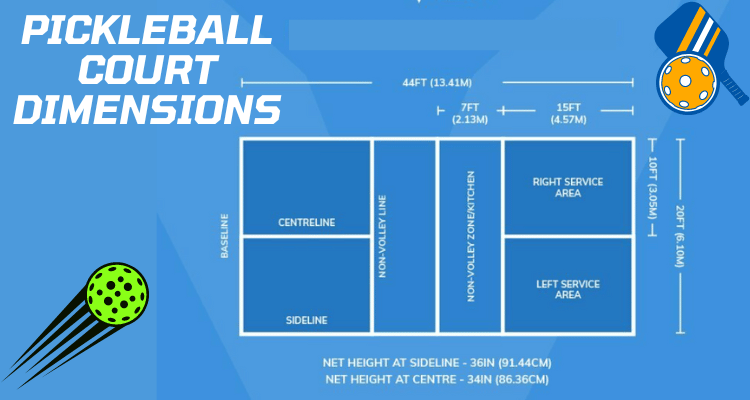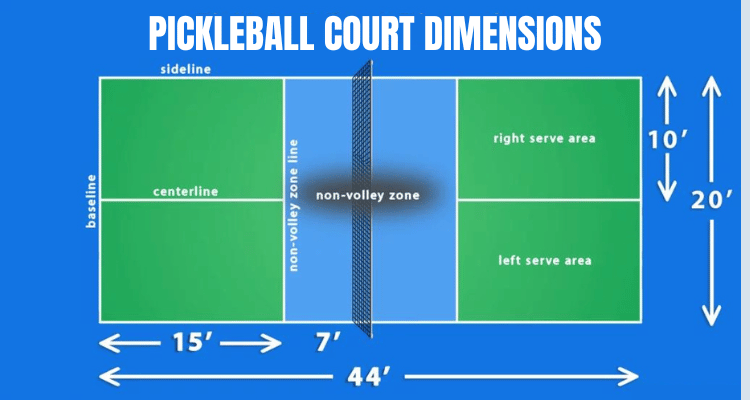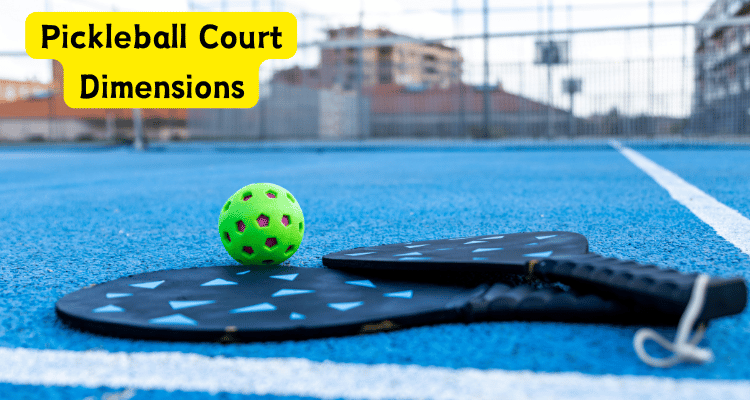Pickleball’s fast-paced, accessible gameplay has made it a favorite for players of all ages, but the court’s unique dimensions are what truly shape the sport’s dynamic feel. Whether you’re setting up a court in your backyard, converting a tennis court, or preparing for tournament play, understanding the exact measurements and layout is critical for fair and enjoyable games. Let’s dive into the precise details of pickleball court dimensions, updated for 2025, to help you get the most out of your playing experience.

Official Pickleball Court Dimensions
The standard Pickleball Court Dimensions, as defined by USA Pickleball, the sport’s governing body, is a rectangle measuring 20 feet wide by 44 feet long (6.10 meters by 13.41 meters). This size applies to both singles and doubles play, making it consistent across all levels of competition. The court’s compact footprint, roughly a quarter the size of a tennis court (36 feet by 78 feet), contributes to pickleball’s quick rallies and strategic depth.
Key Court Measurements
Here’s a breakdown of the court’s core dimensions:
| Area | Dimensions |
|---|---|
| Overall Court Size | 20 feet wide x 44 feet long (6.10 m x 13.41 m) |
| Non-Volley Zone (Kitchen) | 7 feet deep x 20 feet wide (2.13 m x 6.10 m) per side |
| Service Areas | 10 feet wide x 15 feet deep (3.05 m x 4.57 m) each |
| Net Height | 36 inches (91.44 cm) at sidelines, 34 inches (86.36 cm) at center |
| Net Width | 22 feet (6.71 m), extending 1 foot beyond each sideline |
- Non-Volley Zone (Kitchen): The kitchen extends 7 feet from the net on both sides, spanning the court’s full 20-foot width. Players cannot volley (hit the ball without it bouncing) while standing in or touching the kitchen’s boundary lines, adding a strategic layer to gameplay.
- Service Areas: Each half of the court is divided into two service areas by a centerline, each measuring 10 feet wide by 15 feet deep. Serves must land diagonally in the opponent’s service area, beyond the kitchen.
- Baselines and Sidelines: The baseline runs parallel to the net at the back of the court (44 feet long), while sidelines (20 feet long) form the side boundaries. All lines are 2 inches wide and should contrast clearly with the court surface for visibility.
Recommended Playing Area and Clearances
While the court itself is 20 feet by 44 feet, additional space around it is essential for safety and optimal play. USA Pickleball recommends a minimum playing area of 30 feet wide by 60 feet long (9.14 m by 18.29 m) to include out-of-bounds areas. For tournament or high-level play, a larger space of 34 feet by 64 feet (10.36 m by 19.51 m) is preferred to accommodate athletic movement, such as chasing lobs or defending wide shots.
Clearance Guidelines
- Sides: A minimum of 5 feet (1.52 m) on each side, ideally 10 feet (3.05 m), to allow players to move freely without colliding with obstacles or neighboring courts.
- Ends: At least 8 feet (2.44 m) behind each baseline, with 10 feet (3.05 m) preferred, to support deep serves and defensive play.
- Indoor Vertical Clearance: For indoor courts, a ceiling height of 18 to 20 feet (5.49 to 6.10 m) is recommended to prevent the ball from hitting the ceiling during high shots.
These clearances ensure players can swing paddles, pursue shots, and avoid injuries, especially in fast-paced games. For multi-court setups, additional space or dividers between courts prevent interference from stray balls.

Net Specifications
The pickleball net is a critical component that influences gameplay. Its dimensions and setup are standardized to maintain consistency:
- Height: The net measures 36 inches high at the sidelines and dips to 34 inches at the center, creating a slight slope. This design encourages precise serves and prevents overly aggressive shots near the net.
- Width: The net spans 22 feet, extending 1 foot beyond each sideline to ensure full coverage and a taut setup.
- Center Strap: A center strap is recommended for permanent nets to maintain the 34-inch center height. The strap is placed at the court’s midpoint, 10 feet from each sideline.
For tournament play, nets must meet USA Pickleball standards, with sturdy posts and a non-reflective surface to avoid distracting players. Portable nets, like those from ONIX or Selkirk, are popular for temporary setups and should also adhere to these measurements.
Court Layout and Markings
The pickleball court’s layout is designed for clarity and functionality. Here’s how the key zones and lines are organized:
- Centerline: Divides each half of the court into two service areas, running from the non-volley zone line to the baseline.
- Non-Volley Zone Line: Marks the kitchen’s boundary, 7 feet from the net, and spans the full 20-foot width.
- Service Courts: Each service court is defined by the centerline, sidelines, baseline, and non-volley zone line, creating two 10-foot by 15-foot rectangles per side.
- Line Specifications: All lines are 2 inches wide, typically white or a contrasting color, to ensure visibility. Temporary lines can be marked with tape or chalk, while permanent courts use durable paint.
For those converting tennis courts, the pickleball court’s smaller size allows up to four Pickleball courts to fit within a standard tennis court (36 feet by 78 feet). However, temporary lines must be distinguishable to avoid confusion with existing tennis markings.
Surface and Orientation Considerations
The court surface impacts both gameplay and player safety. Common surfaces include:
- Concrete: Durable and low-maintenance, ideal for outdoor courts.
- Asphalt: Affordable but may require more upkeep due to cracking.
- Polyurethane: Often used indoors for cushioning and joint protection.
- Modular Tiles: Snap-together tiles offer grip and flexibility for temporary or multi-sport courts.
When designing a court, orientation matters. USA Pickleball advises a north-south orientation to minimize sun glare, as east-west courts can leave players facing the sun during early morning or late afternoon games.
Setting Up Your Own Pickleball Court
Building a Pickleball Court Dimensions, whether permanent or temporary, requires careful planning. Here’s a step-by-step guide:
- Measure the Space: Ensure you have at least 30 feet by 60 feet, ideally 34 feet by 64 feet, for a single court. For backyard setups, a 36-foot by 65-foot concrete slab is optimal for competitive play.
- Mark the Court: Use a carpenter’s square and measuring tape to outline the 20-foot by 44-foot court. Mark the kitchen (7 feet from the net), centerlines, and service areas with 2-inch-wide tape or paint.
- Install the Net: Set up posts 22 feet apart, ensuring the net is 36 inches high at the sides and 34 inches at the center. Use a center strap for accuracy.
- Add Clearances: Verify sufficient space around the court, especially if fencing or walls are present, to avoid player collisions.
- Choose a Surface: Select a surface based on budget and usage. Concrete is ideal for permanence, while modular tiles suit multi-use spaces.
- Check Orientation and Lighting: Align the court north-south and, for night play, install two 1,500-watt light poles, 18 to 20 feet high, positioned 24 inches back from the court’s center.
For temporary courts, kits like the Franklin Sports Pickleball Court Marker Kit simplify line marking, while portable nets offer easy setup and storage.

Tournament and Professional Standards
For USA Pickleball-sanctioned tournaments in 2025, courts must adhere strictly to the 20-foot by 44-foot dimensions, with a 34-foot by 64-foot playing area for professional play. Additional requirements include:
- Surface Quality: Non-slip surfaces with consistent texture to prevent injuries.
- Lighting: Uniform illumination without shadows, typically via high-mounted LED lights.
- Fencing: Wire or chain-link fencing to contain balls and ensure player safety, especially for multi-court venues.
The Indian Open 2025, held in Mumbai from February 3 to 9, exemplifies these standards, with over 25 courts built to international specifications, highlighting pickleball’s global growth.
Frequently Asked Questions (FAQs)
What are the official dimensions of a pickleball court?
The official pickleball court size, as set by USA Pickleball, is 20 feet wide by 44 feet long (6.10 m x 13.41 m) for both singles and doubles play.
How big is the non-volley zone or kitchen in pickleball?
The non-volley zone, or kitchen, measures 7 feet deep by 20 feet wide (2.13 m x 6.10 m) on each side of the net.
What is the recommended space around a pickleball court?
USA Pickleball recommends a minimum playing area of 30 feet by 60 feet, with 34 feet by 64 feet preferred for tournament play to allow safe movement.
What is the height of a pickleball net?
The net is 36 inches high at the sidelines and 34 inches at the center, with a width of 22 feet, extending 1 foot beyond each sideline.
Can a tennis court be converted to a pickleball court?
Yes, a standard tennis court (36 feet by 78 feet) can fit up to four pickleball courts. Temporary lines should be clearly marked to avoid confusion with tennis lines.
What surface is best for a pickleball court?
Concrete is ideal for outdoor courts due to durability, while polyurethane suits indoor courts for cushioning. Modular tiles work well for temporary setups.
How much space do I need for a backyard pickleball court?
A minimum of 30 feet by 60 feet is needed, but 36 feet by 65 feet is ideal for competitive play, including clearances for safety.
What are the line width requirements for a pickleball court?
All court lines, including baselines, sidelines, and the non-volley zone line, must be 2 inches wide and clearly visible.
Why is court orientation important in pickleball?
A north-south orientation minimizes sun glare, ensuring players aren’t blinded during early morning or late afternoon games.
What are the requirements for a tournament Pickleball Court Dimensions?
Tournament courts must be 20 feet by 44 feet, with a 34-foot by 64-foot playing area, non-slip surfaces, proper lighting, and secure fencing.
Why Dimensions Matter
Precise court dimensions are more than just numbers they shape strategy and fairness. The kitchen’s 7-foot depth forces players to balance power shots with finesse, while the compact court size keeps rallies intense and accessible. Proper clearances prevent injuries, and correct net height rewards skillful serves. Whether you’re a casual player or aiming for the Indian Open, understanding these measurements enhances your game and ensures compliance with official rules.
By following USA Pickleball’s 2025 guidelines, you can create a court that’s ready for fun, competition, or both. So grab your paddle, mark those lines, and get ready to dink, serve, and rally on a perfectly proportioned pickleball court!
Sources:
- Pickleball Court Experts
- USA Pickleball 2025 Rulebook
- VersaCourt Pickleball Court Dimensions
- Pacecourt Pickleball Court Guide




